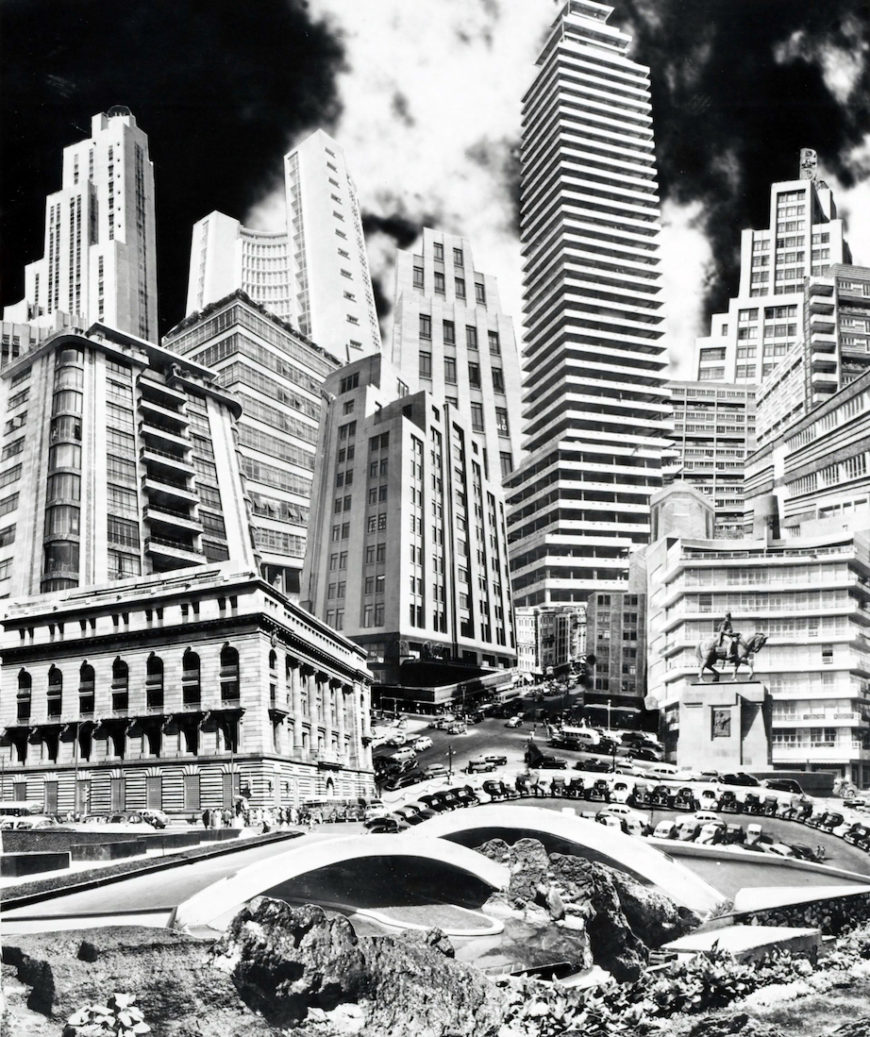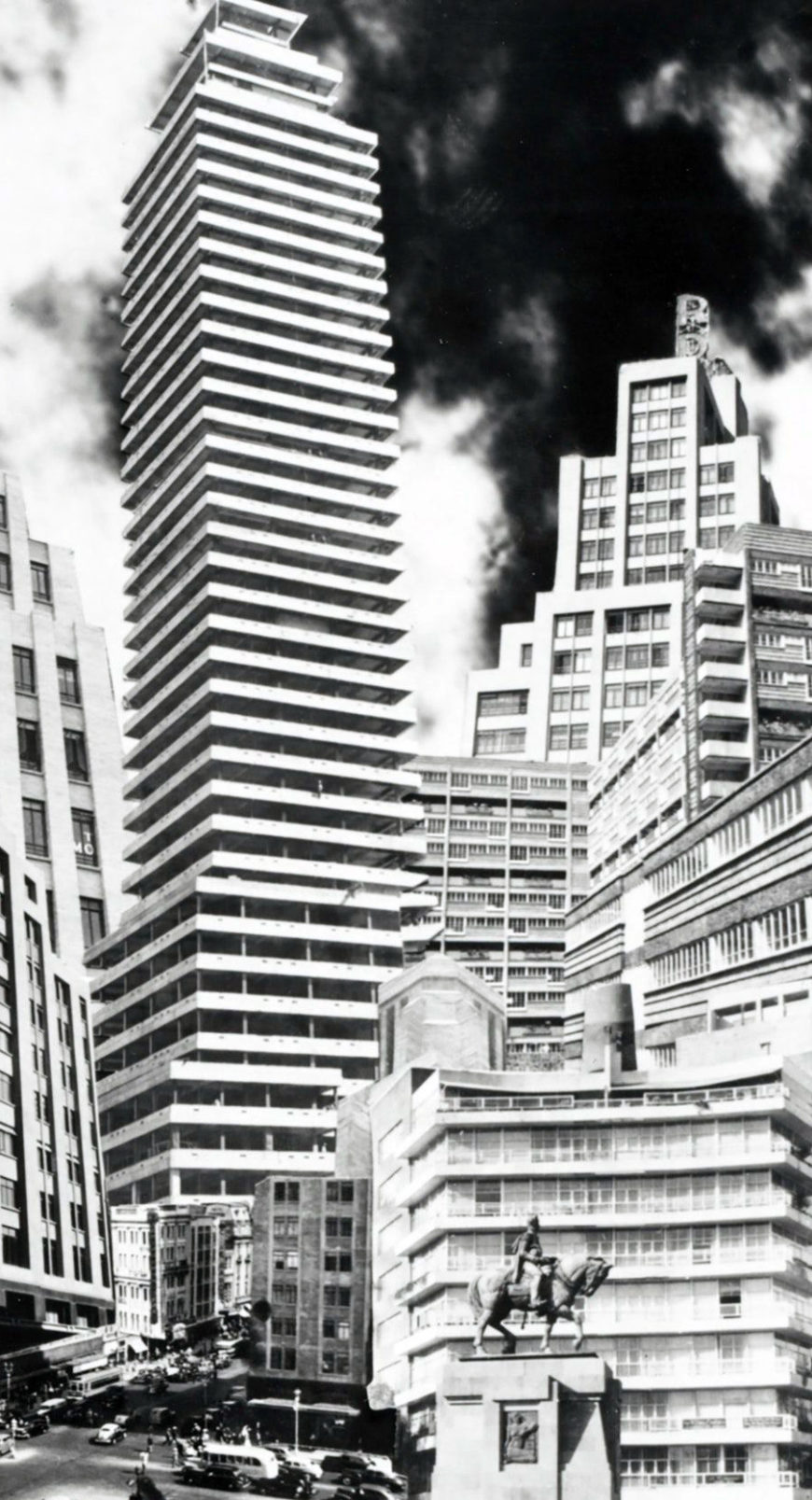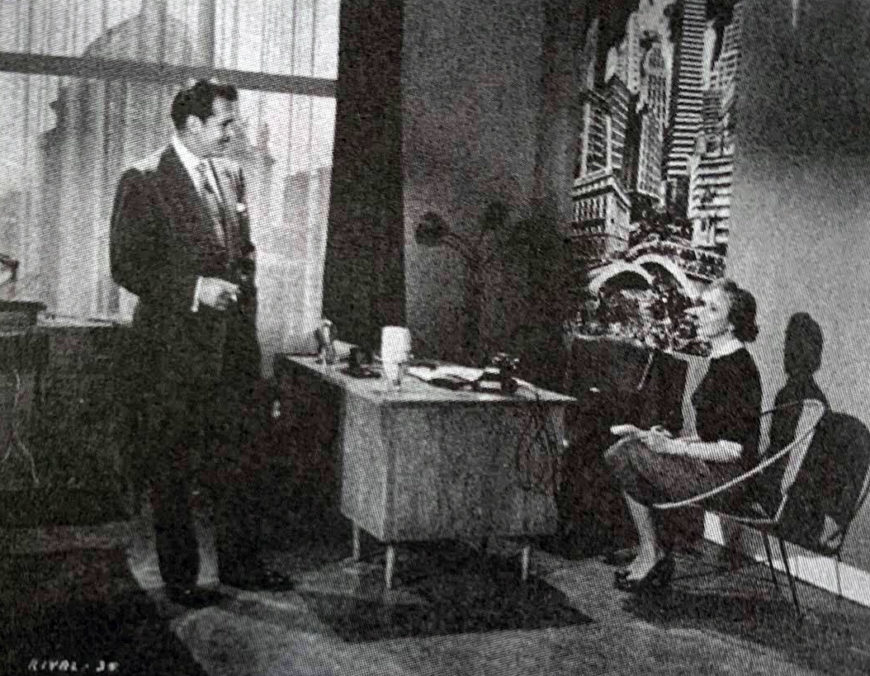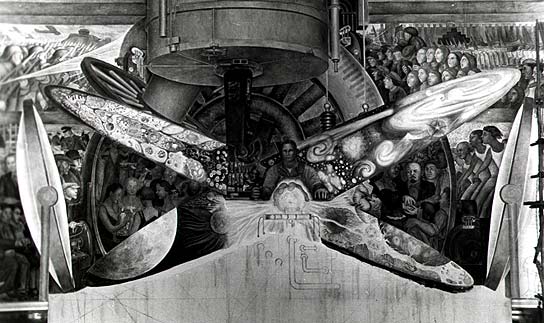
Lola Álvarez Bravo, Anarquía Arquitectónica en la Ciudad de México (Architectural Anarchy in Mexico City), 1954, gelatin silver print, 21.4 x 17.7 cm (© Center for Creative Photography, The University of Arizona Foundation)
Mexican photographer Lola Álvarez Bravo thought architecture could be subversive and revolutionary. She expressed this view using Mexico City’s growing and changing urban landscape in her photomontage Anarquía Arquitectónica en la Ciudad de México (Architectural Anarchy in Mexico City). Created in 1954, the photograph was created by cutting and pasting images from different sources that Álvarez Bravo then re-photographed to create a new seamless print. It deploys a chaotic and overwhelming view of some of Mexico City’s most emblematic buildings. Álvarez Bravo’s photomontage of about 14 different edifices creates a modern and overwhelming concrete jungle, whose height is exaggerated by the play of scales between the different constructions, as well as their contrast with the human scale (in the foreground of the picture, very small people walk through the streets of this imaginary environment built on a defiant rocky landscape at the bottom of the picture plane).
The changing city

Lola Álvarez Bravo, detail showing the Torre Latinoamericana and a staute of Simón Bolívar, Anarquía Arquitectónica en la Ciudad de México (Architectural Anarchy in Mexico City), 1954, gelatin silver print, 21.4 x 17.7 cm (© Center for Creative Photography, The University of Arizona Foundation)
To the right of Anarquía‘s center, touching the upper border of the picture, we see the Torre Latinoamericana (built in 1949)—Mexico City’s most emblematic modern building and Latin America’s first skyscraper. The construction of this building marked the country’s transition to modernity. Before this time, Mexico was immersed in what is known as the post-revolutionary period. After Mexico’s independence from Spain in 1821, the country entered a period of consolidation as an independent nation. In 1876, General Porfirio Díaz was elected president and he ruled the country for more than 30 years. He consolidated the central power of the state, strengthened the capitalist sector, and promoted foreign investment. The economy boomed during Díaz’s regime. However, the increase of wealth was concentrated among urban elites while the majority Mexico’s population was rural and Indigenous. This widened the gap between social classes and ultimately led to the Mexican Revolution of 1910–20. By the time the Torre Latinoamericana was built, the post-revolutionary period (c. 1920–40) was finally over.
In Anarquía, the Torre punches through the top edge of the picture plane and divides Álvarez Bravo’s composition in two. It forms the central axis of the artwork. Upon closer inspection, it appears that the Torre Latinoamericana was still under construction when it was photographed, as the glass windows were not yet installed.
The contrast of tall modern buildings and older ones, such as the horizontal Banco de México building (built between 1903 and 1905) in the lower left, conveys the modern turn and the economic affluence that the country experienced at the time the photomontage was made. Beginning in the 1940s, the country was entering a new phase known as “el milagro mexicano” (the Mexican miracle). This new period was characterized by sustained economic growth and the change towards the formation of a modern and industrialized nation. Álvarez Bravo’s photomontage seems to anticipate the rapid growth of Mexico City. In 1940, the city had a total of 1.8 million people. When Álvarez Bravo made the photomontage in 1954, Mexico City had around 3 million inhabitants—by 1980, it had become a megalopolis of more than 14 million people.
The tension between Mexico’s traditional past and its modern future is further reinforced by the inclusion of Simón Bolívar’s statue to the right of the Torre Latinoamericana. Bolívar was a Venezuelan military and political leader, who led territories of the Spanish Empire (today Colombia, Panama, Venezuela, Ecuador, Bolivia and Peru) to independence. The presence of his statue in Anarquía points to Mexico’s shared colonial past within the Americas; Mexico was once part of the viceroyalty of New Spain, a territory that was under the power of the Spanish Empire from 1519 until its independence in 1821. In Anarquía, Bolívar’s statue stands in front of mid-twentieth century modern buildings, such as those designed by architect Mario Pani, who was credited with introducing International Style architecture to Mexico. Álvarez Bravo’s composition exposes the diverse paths and styles that modern Mexican architecture followed. However, the photomontage also conveys a sense of skepticism about modernity through its overwhelmingly chaotic assemblage of buildings.
Photomontage
The impulse to create images like Anarquía was explained by Álvarez Bravo herself:
Sometimes I wanted to say something, and photography didn’t fully allow me to do it. So I’d take a sheet of cardboard, make a drawing, select the negatives, print them the necessary size, then cut and paste. [1]
She created Anarquía utilizing her own photographic negatives, which allowed her a greater degree of control over the viewpoint, scale, lighting, and composition of the final image. By the time she created this picture, she had already had a prolific career as a photographer beginning in 1934, after she separated from the renowned photographer Manuel Álvarez Bravo. She worked in different genres and styles, including portraiture and unmanipulated Straight Photography to document the Indigenous and peasant populations of Mexico. Her work was featured in several magazines, and she worked for both government agencies and private patrons. With Anarquía, we see her use of political photomontage, which was popular in the 1930s in Mexico. Besides Lola Álvarez Bravo, artists such as Tina Modotti, Agustín Jiménez, Emilio Amero, and Antonio and Rafael Carrillo had started to use the medium.
The origins of avant-garde artists’ use of photomontage can be traced back to German Dada artists Hannah Höch, Raoul Hausmann, and John Heartfield, as well as to Soviet artists Varvara Stepanova, Alexander Rodchenko, and El Lissitzky. In these European artists’ contexts, it was mainly utilized to express opinions about politics or social and cultural issues.
Álvarez Bravo’s work draws on both local and foreign traditions of photomontage. Her oeuvre was most certainly inspired by the work of Dada and Soviet artists, whose photomontages circulated in Mexico in leftist magazines.
Photomontage and muralism
Álvarez Bravo’s regard for architecture was cultivated throughout her 50-year career. By the time she created Anarquía, Álvarez Bravo was on the editorial board of the magazine Espacios, a journal that promoted architecture and the fine arts.

Unidentified photographer, still from the motion picture La rival, 1955, gelatin silver (Collection of the Biblioteca de Arte Ricardo Pérez Escamilla)
Anarquía was first published on the cover of the magazine Arquitectura / México in 1955, but it was introduced to a mass audience when it was shown as a photographic mural in the background of the 1955 film La rival, directed by Chano Urueta. The film tells the story of an architect who was having an affair. Álvarez Bravo’s photomontage was enlarged to fill a wall in the protagonist’s office, where it was juxtaposed with a real-life view of colonial-era buildings from the office’s windows. The encounter between the past and a chaotic future is a visual metaphor for the film’s plot.
Álvarez Bravo’s Anarquía also challenged modern Mexican painting, while expressing skepticism about the future. In other words, she was not sure that the rapid modernization process as expressed through architecture was necessarily something good. She used photographic murals (such as Anarquía became because of the film) to inscribe herself into Mexico’s male-dominated, most emblematic twentieth-century artistic tradition: muralism. By introducing a modern medium—photography—she challenged the more traditional fresco painting technique of the muralism movement associated with the “tres grandes” (Diego Rivera, David Alfaro Siqueiros, and José Clemente Orozco). Anarquía was not Álvarez Bravo’s first photographic mural.

Lola Álvarez Bravo, Hilados del Norte I, c. 1944, gelatin silver print, 14.9 x 31 cm (Ackland Art Museum)

Diego Rivera, Man at the Crossroads, 1933, Rockefeller Center, New York (destroyed)
In the 1940s and 1950s, she was commissioned to create a series of large-scale photographs to be publicly displayed. The most famous was Hilados del Norte I, created for a textile factory in Monterrey. This photographic mural was in direct dialogue with Diego Rivera’s Man at the Crossroads, the mural he initially created for New York’s Rockefeller Center, but which was destroyed before its official unveiling. (Rivera created a second version of this mural for Mexico’s Palacio de Bellas Artes, where it still stands.) Both Hilados del Norte I and Man at the Crossroads revolve around a central powerful figure, and from which diagonal lines that guide navigation of the compositions emerge. Giant disembodied hands appear in both artworks as the ultimate directors of their surroundings. The strategy of replacing the old medium of fresco with that of photography conveyed the transition from an art form that had once been revolutionary—but that by the 1940s had become outdated—to a medium that aligned with a modern view of the world: photography was machine-made, reproducible, and truly accessible to the masses. Like in Anarquía, Álvarez Bravo used photomontage to create Hilados del Norte I, which was enlarged to cover an entire wall and evoked the scale of mural painting. As she stated:
The photographic mural can be executed as a photomontage or through the projection of a single real subject that makes it possible to expand perspectives, landscape, and luminosity, which offers in turn to the viewer the possibility of being rapidly transported to a different setting. [2]
As art historian James Oles has suggested, Álvarez Bravo wanted to elevate the status of photomontage to that of muralism. [3]
A critique and a challenge
Anarquía Arquitectónica en la Ciudad de México (Architectural Anarchy in Mexico City) not only conveys a critique towards the rapid growth of modernist architecture characteristic of changing time in Mexico, but it also challenges Mexican muralism. Her photomurals take a different stance to that of the “tres grandes” even though she shared their leftist beliefs. With pictures such as Anarquía, Alvarez Bravo inserted herself within the practice of a male-dominated artistic world, addressing new contemporary issues such as the changing urban landscape through a new modern medium.




